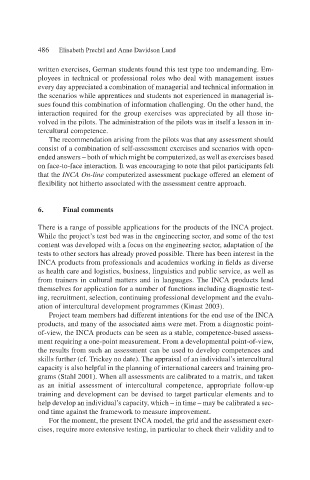Page 508 - Handbooks of Applied Linguistics Communication Competence Language and Communication Problems Practical Solutions
P. 508
486 Elisabeth Prechtl and Anne Davidson Lund
written exercises, German students found this test type too undemanding. Em-
ployees in technical or professional roles who deal with management issues
every day appreciated a combination of managerial and technical information in
the scenarios while apprentices and students not experienced in managerial is-
sues found this combination of information challenging. On the other hand, the
interaction required for the group exercises was appreciated by all those in-
volved in the pilots. The administration of the pilots was in itself a lesson in in-
tercultural competence.
The recommendation arising from the pilots was that any assessment should
consist of a combination of self-assessment exercises and scenarios with open-
ended answers – both of which might be computerized, as well as exercises based
on face-to-face interaction. It was encouraging to note that pilot participants felt
that the INCA On-line computerized assessment package offered an element of
flexibility not hitherto associated with the assessment centre approach.
6. Final comments
There is a range of possible applications for the products of the INCA project.
While the project’s test bed was in the engineering sector, and some of the test
content was developed with a focus on the engineering sector, adaptation of the
tests to other sectors has already proved possible. There has been interest in the
INCA products from professionals and academics working in fields as diverse
as health care and logistics, business, linguistics and public service, as well as
from trainers in cultural matters and in languages. The INCA products lend
themselves for application for a number of functions including diagnostic test-
ing, recruitment, selection, continuing professional development and the evalu-
ation of intercultural development programmes (Kinast 2003).
Project team members had different intentions for the end use of the INCA
products, and many of the associated aims were met. From a diagnostic point-
of-view, the INCA products can be seen as a stable, competence-based assess-
ment requiring a one-point measurement. From a developmental point-of-view,
the results from such an assessment can be used to develop competences and
skills further (cf. Trickey no date). The appraisal of an individual’s intercultural
capacity is also helpful in the planning of international careers and training pro-
grams (Stahl 2001). When all assessments are calibrated to a matrix, and taken
as an initial assessment of intercultural competence, appropriate follow-up
training and development can be devised to target particular elements and to
help develop an individual’s capacity, which – in time – may be calibrated a sec-
ond time against the framework to measure improvement.
For the moment, the present INCA model, the grid and the assessment exer-
cises, require more extensive testing, in particular to check their validity and to

